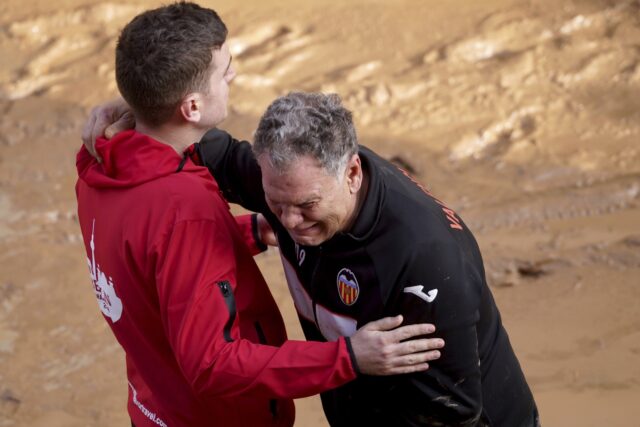Survivors of worst natural disaster to hit Spain this century have awoken to scenes of devastation after villages were wiped out by monstrous flash floods that claimed at least 95 lives
Spain searches for bodies after flood of the century claims at least 95 livesBy ALBERTO SAIZ and JOSEPH WILSONAssociated PressThe Associated PressBARRIO DE LA TORRE, Spain
BARRIO DE LA TORRE, Spain (AP) — Survivors of the worst natural disaster to hit Spain this century awoke to scenes of devastation on Thursday after villages were wiped out by monstrous flash floods that claimed at least 95 lives. The death toll is expected to rise as search efforts continue with officials removing bodies from vehicles and an unknown number of people still missing.
“Unfortunately, there are dead people inside some vehicles,” said Spain’s Transport Minister Óscar Puente in reference to hundreds of cars and trucks stranded on roads stained brown with mud.
The aftermath of the floods looked eerily similar to the damage left by a strong hurricane or tsunami.
Cars piled on one another like broken toys, uprooted trees, downed power lines and household items all mired in a layer of mud covered the streets of Barrio de la Torre, a suburb of Valencia, just one of dozens of damaged localities in the hard-hit region of Valencia, where 92 people died between late Tuesday and Wednesday morning.
Walls of rushing water turned narrow streets into death traps and spawned rivers that ripped into the ground floors of homes and swept away cars, people and anything else in its path.
“The neighborhood is destroyed, all the cars are on top of each other, it’s literally smashed up,” said Christian Viena, a bar owner in Barrio de la Torre.
Regional authorities said late Wednesday it appeared there was no one left stranded on rooftops or in cars in need of rescue after helicopters had saved some 70 people. But ground crews and citizens continued to inspect vehicles and homes that were damaged by the onslaught of water.
Over a thousand soldiers from Spain’s emergency rescue units joined regional and local emergency workers in the search for bodies and survivors. The defense minister said that soldiers alone had recovered 22 bodies and rescued 110 people by Wednesday night.
“We are searching house by house,” Ángel Martínez, official of a military emergency unit, told Spain’s national radio broadcaster RNE on Thursday from the town of Utiel, where at least six people died.
Spanish Prime Minister Pedro Sánchez is heading to the region to witness the destruction firsthand as the nation starts a three-day period of official mourning.
Thousands of people were left without water and electricity and hundreds were stranded after their cars were wrecked or roads were blocked. The region remained partly isolated with several roads cut off and train lines interrupted, including the high-speed service to Madrid, which officials say won’t be repaired for several days.
While Valencia took the brunt of the storm, another two casualties were reported in the neighboring Castilla La Mancha region. Southern Andalusia reported one death.
While the greatest human and material suffering was inflicted on the dozens of municipalities near Valencia city, the storms unleashed their fury over huge swathes of the south and eastern coast of the Iberian peninsula. Homes were left without water as far southwest as Malaga in Andalusia, where a high-speed train derailed on Tuesday night although none of the nearly 300 passengers were hurt.
The greenhouses and fields of farmers all over the southern arc of Spain, which is known as Europe’s garden for its exported produce, were also ruined by heavy rains, flooding and winds. The storms spawned a freak tornado in Valencia and a hail storm that punched holes in cars in Andalusia.
The skies showed some mercy for the worst-hit areas by stopping early on Wednesday. But heavy rains continued Thursday farther north and the Spanish weather agency issued a red alert for several counties in Castellón, the northernmost province in the Valencia region, and an orange alert for the south of Tarragona, in northeast Catalonia, and the west coast of Cádiz, in the southwest.
Spain’s Mediterranean coast is used to autumn storms that can cause flooding. But this was the most powerful flash flood event in recent memory. Scientists link it to climate change, which is also behind increasingly high temperatures and droughts in Spain and the heating up of the Mediterranean Sea.
The violence of the weather event surprised regional government officials. Spain’s national weather service said it rained more in eight hours in the Valencian town of Chiva than it had in the preceding 20 months, calling the deluge “extraordinary.”
Yet the relative calm of the day after also gave time to reflect and question if authorities could have done more to save lives. The Valencian regional government is being criticized for not sending out flood warnings to people’s mobile phones until 8:00 p.m. on Tuesday, when the flooding had already started in some parts and well after the national weather agency had issued a red alert for heavy rains.
Andreu Salom, mayor of the Valencian village of L’Alcudia, told national broadcaster RTVE that his town had lost at least two residents, a daughter and her elderly mother who lived together, and that police were still searching for the missing truck driver.
“We didn’t have any indication that the river was going to overflow its banks, which happened around 6:00 p.m. when a wall of water and mud filled the town center and washed away everything,” he said.
___
Wilson reported from Barcelona, Spain. Teresa Medrano contributed from Madrid.

COMMENTS
Please let us know if you're having issues with commenting.